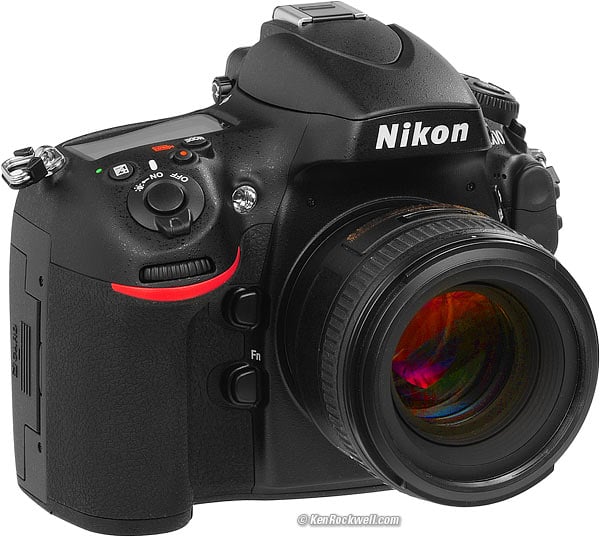Home Donate New Search Gallery Reviews How-To Books Links Workshops About Contact
Nikon
D800 and D800E User's Guide:
Custom Setting Menu: Bracketing/flash
© 2012 KenRockwell.com. All rights reserved.

Nikon D800 and 50mm f/1.4 G. enlarge.
July 2012 D800 and D800E Review Nikon Reviews Nikon Lenses All Reviews
Top of D800 and D800E User's Guide
Help me help you top
I support my growing family through this free website. The biggest help is when you use any of these links when you get anything, regardless of the country in which you live.
If you find this page as helpful as a book you might have had to buy or a workshop you may have had to take, feel free to help me continue helping everyone.
While free to read online, this page is formally registered and copyrighted, so it is unlawful to make copies, especially in the form of printouts for personal use or saving these pages or files. If you wish to make a printout for personal use, you are granted one-time permission to print from your browser (there is no PDF) only if you PayPal me $5.00 per printout, file save, or part thereof, unless of course you bought your D800 through one of my links. This is how I justify spending weeks away from my family writing and sharing all this for free online.
Thank you and thanks for your support!
Custom Settings
Menu:
Bracketing/flash
Want free live phone support? In the USA, call (800) NIKON-UX, 24 hours a day, 365 days a year.
e1 - e7: Bracketing/flash
How to Get Here
Press MENU, go to the left and select up and down to the pencil icon. You'll then see CUSTOM SETTING MENU on the color LCD.
Click down to e BRACKETING/FLASH and click to the right.
What it Does
It sets flash functions and other completely unrelated bracketing options.
What I Change
I usually change e2 and e4.
e1 Flash Sync Speed top
Flash Sync Speed is the fastest shutter speed that the D800 or D800E will use with flash in their P or A auto modes.
This lets you select a slower maximum flash sync speed. You might want to choose a slower speed to let in more ambient light, but I select that with the next option.
This menu lets you select 1/60 through 1/250.
It also is where you must select AUTO FP if you wish to use the trick FP high-speed sync modes.
e2 Flash Shutter Speed top
Flash Shutter Speed sets the slowest shutter speed that the D800 or D800E will use with flash in their P or A auto modes.
1/60 is default. I usually set about 1/30 or 1/15 to let in more ambient light to prevent my backgrounds from blacking-out.
Slower speeds like 1/8 let the backgrounds stay much lighter, but greatly increase the chances of motion blur.
e3 Flash cntrl for built-in flash top
This sets what the built-in flash does.
TTL (default)
By default it works like a TTL flash.
That's good; it works great.
Leave it here.
M (Manual)
You set the flash brightness manually.
I use this mode if I'm shooting my studio strobes and using the built-in flash to trigger my studio strobes, setting the D800 flash to a low level to fire my big flashes.
RPT (idiotic repeating strobe mode)
Har har, you can start you own hamster disco with this one.
CMD (commander mode)
This is how to set the built-in flash to become the commander to talk to a wireless remote flash, like the SB-600, SB-700, SB-800, SB-900 and SB-910.
Under this menu you can set two groups of external flashes separately, as well as how much light comes from the built-in flash.
"Comp" is the exposure compensation (brightness) for each of these groups of lights.
You can set lighting ratios of remote flashes, right from the D800 and D800E!
Trick: You probably have to set Channel 3, not the default of 1, to get this to work! My SB-600 defaults to channel 3. You can use any channel, but the flash and camera have to match. Different channels are handy if you have a lot of photographers shooting in the same arena. No, I have no idea why the D70 defaults to 3 as does the SB-600, and the D800 and D800E defaults to ch. 1.
Leave the rest of it alone. Set your flash for remote operation, and away you go.
See how to use remote wireless flash. It's an incredible feature, and it's free if you have an SB-600, SB-700, SB-800, SB-900 or SB-910.
e4 Modeling Flash top
Turn this off!
Otherwise you'll go blind, because at its default, a design flaw, it fires a zillion flash shots as a modeling light if you tap the Depth-of-Field preview button.
e5 Auto BKT Set top
This controls what changes when you have the D800 and D800E bracket.
You can have everything change exposure (AE & flash), or just the flash (flash), or just the ambient light (AE only), or have the WB or ADR bracket.
I never use these. Bracketing is for the weak. Use your LCD and look at your pictures. This feature is a left-over from film cameras, and real photographers never used bracketing with film either.
I set my BKT button for HDR anyway.
e6 Auto bracketing (mode M) top
This controls what changes when letting the D800 and D800E bracket itself in manual exposure mode.
I never use this.
e7 Bracketing order top
This sets the order in which the various bracketed exposures are made, presuming you're shooting sets of bracketed shots.
Top of D800 and D800E User's Guide
AUTOFOCUS
Setting the D800 and D800E's Autofocus System
KNOBS and BUTTONS
MENUS
f Controls < < NEXT
Home Donate New Search Gallery Reviews How-To Books Links Workshops About Contact
